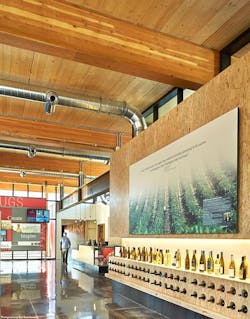Schooling the visitor
Washington State University holds a deep affinity for wood products and technologies, and nowhere is that more evident than the new Brelsford WSU Visitor Center in Pullman, Washington. By showcasing building materials developed in part at the university, this Center helps visitors learn about the contributions WSU has made to the industry.
Glulam beams and columns form the framework for the 4,277 square-foot building. Cross-laminated timber (CLT) ceilings are visible to those below and oriented strand board (OSB) panels frame the front desk and wine display.
All were left exposed to visitors, paying tribute to the role WSU’s Composite Materials & Engineering Center played in their development. The result, says project architect and design collaborator Steven Rainville of Olson Kundig, is a building that “is legible. You can read how it came together.”
Glulam beams, CLT roof panels and OSB wall panels are left exposed to highlight engineered building product technologies which were developed, in part, at WSU.
Glulam Pays Homage to its History
The Northwest’s “tradition of glulam technology,” as Rainville describes it, is evident throughout the WSU campus, and those deeply held beliefs in and respect for wood technology are on vibrant display throughout the new Visitor Center.
Designers chose glulam beams and columns to construct the six structural frames for the roof deck. Glulam was a cost-effective option for the project’s needs while offering a look that ideally complements the CLT roof deck. Glulam was also chosen to pay homage to the university’s strong ties to the industry, since WSU researchers helped further develop the modern glulam product through their work years ago.
Half of the building serves as an exhibit hall, constructed of glass, steel and wood. The large CLT roof overhang is supported in part by 15-foot-tall concrete letters spelling “W-S-U” just outside of the high-ceilinged pavilion. The other half of the structure is wood-framed and houses offices and restrooms.
Quick Installation
The ease and speed of wood construction was crucial to this project, which took just 10 months from design to completion. CLT roof components were prefabricated; the entire roof was then assembled onsite.
Architects chose 8-foot-by-40-foot structural CLT panels to frame the 100-foot-by-50-foot roof deck because they could be installed quickly. The University awarded the project in January 2013, construction began in May, and the design/build team finished the project in October.
By leaving the interiors of the structure exposed, the builders were able to skip drywall and painting, a design decision that further sped construction. “The structure is your finish,” says Rainville. “You sand it, you finish it, and you’re done.”
Installation was quicker in part because, unlike poured-in-place concrete, the 4-inch-thick CLT panels come off the truck ready to install. The panels also are up to six times lighter and one-third thinner than concrete and required fewer skilled laborers on the jobsite.
Project manager Dave Scalzo, a senior vice president at Sellen Construction, says installation of the CLT—his first—went flawlessly. “It was no different from working with other wood,” he notes.
Commitment to Sustainability
The CLT was manufactured from wood damaged by pine beetles that would have otherwise been discarded, which also appealed to Rainville, an advocate of incorporating dead and dying logs into engineered wood panels and beams. “Architects can do the right thing and create a market for this by specifying it,” he says.
Mountain pine beetles have killed millions of acres of trees in the Rocky Mountains —mostly ponderosa and lodgepole pine—since 1996. The pests lay their eggs beneath the bark and infect the wood with fungal spores that leave colored (typically blue, purple, gray or brown) spots, streaks and patterns in the wood.
Though discolored, the wood is still structurally sound and therefore can still be used, as it was for the CLT panels. On some sections of the CLT, some light gray streaking is visible, but Rainville calls it “inconsequential. … We weren’t concerned about that. We were more concerned that the log is dead. We were motivated by the opportunity to directly address what is really a human-influenced environmental disaster and in a small way do something constructive out of its ongoing destructive results.” In some applications, such as a wood bench inside the Center, the natural blue stain adds visual interest.
Reflection of Priorities
All of the wood-based building materials used in the project were developed using technology created by the WSU Composite Materials & Engineering Center, a recognized world leader in the development of sustainable composite materials. By featuring these exposed wood members, the Center speaks directly to the university’s commitment to sustainable and innovative building construction, providing visitors with a clear understanding of the University’s mission.


